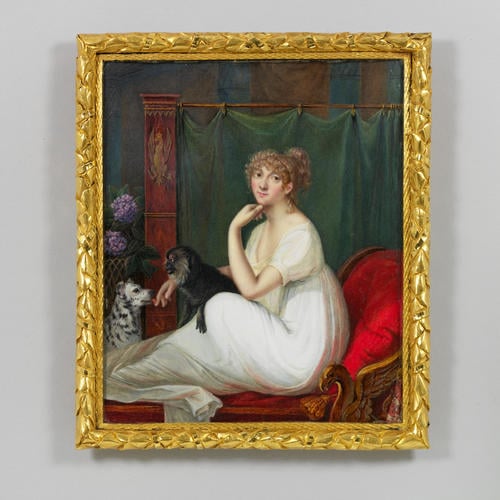-
1 of 253523 objects
Frederica, Duchess of York (1767-1820) 1803
Watercolour on ivory | 12.8 x 10.6 cm (sight) | RCIN 421001

Jean-François-Marie Hüet-Villiers (1772-1813)
Frederica, Duchess of York (1767-1820) 1803
-
Princess Frederica Charlotte (1767-1830) was the only daughter of Crown Prince Frederick William of Prussia (1744-97), later King Frederick William II, and his first wife Elisabeth Christine of Brunswick-Lüneburg (1746-1840). Her parents divorced in 1769 and Frederica was brought up by her paternal grandmother, Princess Luise Amalie, and her stepmother, Frederika Louisa of Hesse-Darmstadt, who married the crown prince almost immediately after his divorce. In 1791, Frederica married Prince Frederick, Duke of York and Albany, the second son of George III. She received an enthusiastic welcome in London, but the marriage was not a happy one and the couple soon separated. Frederica retired to Oatlands Park in Weybridge, where she lived until her death in 1830. Frederica kept a menagerie of animals at Oatlands. The diarist and dandy Thomas Raikes remembered, ‘There were some twenty or thirty different sorts in the house; and many a morning have I, to my annoyance, been awakened from an incipient slumber, after a long sitting at whist, by the noisy pack rushing along the gallery next to my bedroom, at the call of old Dawe, the footman, to their morning meal’. There was also ‘a colony of monkeys on the lawn and eagles in the menagerie’.
Jean-François-Marie Hüet-Villiers (1772-1813) was the son of J. B. Hüet, a painter, who taught him art. He took the name Villiers from Villier-sur-Orge where his father owned land. In 1792, he enlisted and only took up painting when he left the army. He exhibited at the Paris Salon between 1799 and 1803, then settled in London. He exhibited at the Royal Academy and Associated Artists in Water Colour (of which he was a founder member) from 1803 to 1813. He was appointed miniature painter to the Duke and Duchess of York in 1805 and exhibited portraits of both of them in 1803 and 1806, and a portrait of Gustavus IV, King of Sweden, in 1812. He was a versatile artist, drawing landscapes, animals and architecture, but excelled in his portraits in miniature on ivory, alabaster and marble, and in larger size in oils and chalk. He died in London and is buried in St Pancras churchyard.
The miniature is signed and dated on the upper right: Vi … Hue …, the date is illegible.
Provenance
First recorded in the Royal Collection in 1851
-
Medium and techniques
Watercolour on ivory
Measurements
12.8 x 10.6 cm (sight)
14.9 x 12.6 cm (frame, external)
Category
Object type(s)
Other number(s)
Cust 1910 : Cust, L., 1910. Windsor Castle: Portrait Miniatures, London – Cust 1910 Supplement 1RL 1870 9.B.5.